大学英语跨文化交际presentation
- 格式:ppt
- 大小:165.00 KB
- 文档页数:7
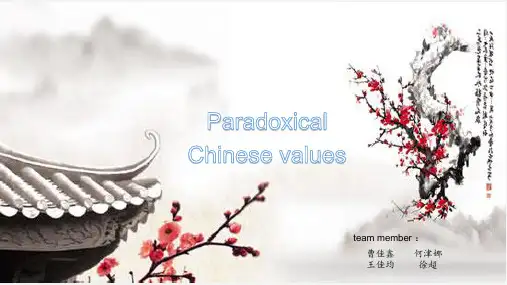
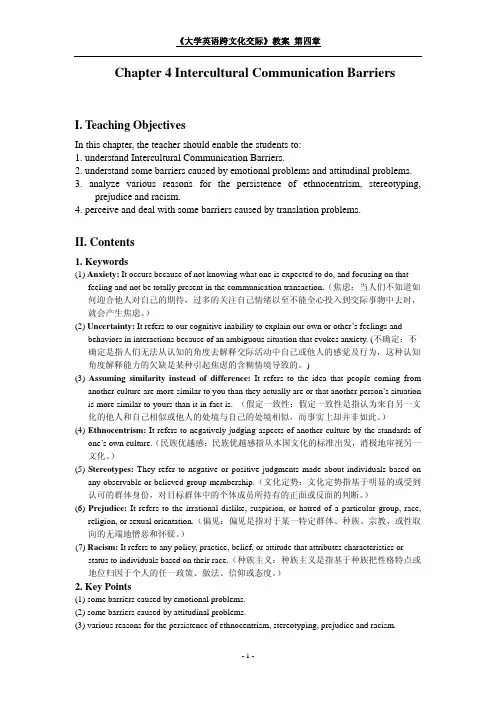
Chapter 4 Intercultural Communication BarriersI. Teaching ObjectivesIn this chapter, the teacher should enable the students to:1. understand Intercultural Communication Barriers.2. understand some barriers caused by emotional problems and attitudinal problems.3. analyze various reasons for the persistence of ethnocentrism, stereotyping,prejudice and racism.4. perceive and deal with some barriers caused by translation problems.II. Contents1. Keywords(1) Anxiety: It occurs because of not knowing what one is expected to do, and focusing on thatfeeling and not be totally present in the communication transaction.(焦虑:当人们不知道如何迎合他人对自己的期待,过多的关注自己情绪以至不能全心投入到交际事物中去时,就会产生焦虑。
)(2) Uncertainty: It refers to our cognitive inability to explain our own or other’s feelings andbehaviors in interactions because of an ambiguous situation that evokes anxiety. (不确定:不确定是指人们无法从认知的角度去解释交际活动中自己或他人的感觉及行为,这种认知角度解释能力的欠缺是某种引起焦虑的含糊情境导致的。
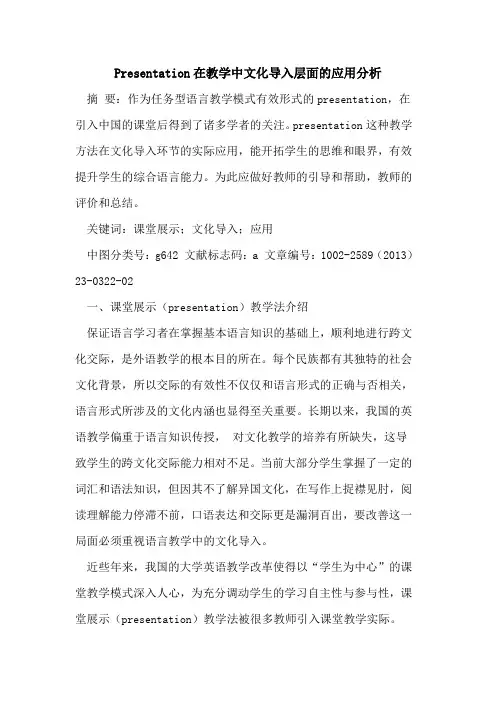
Presentation在教学中文化导入层面的应用分析摘要:作为任务型语言教学模式有效形式的presentation,在引入中国的课堂后得到了诸多学者的关注。
presentation这种教学方法在文化导入环节的实际应用,能开拓学生的思维和眼界,有效提升学生的综合语言能力。
为此应做好教师的引导和帮助,教师的评价和总结。
关键词:课堂展示;文化导入;应用中图分类号:g642 文献标志码:a 文章编号:1002-2589(2013)23-0322-02一、课堂展示(presentation)教学法介绍保证语言学习者在掌握基本语言知识的基础上,顺利地进行跨文化交际,是外语教学的根本目的所在。
每个民族都有其独特的社会文化背景,所以交际的有效性不仅仅和语言形式的正确与否相关,语言形式所涉及的文化内涵也显得至关重要。
长期以来,我国的英语教学偏重于语言知识传授,对文化教学的培养有所缺失,这导致学生的跨文化交际能力相对不足。
当前大部分学生掌握了一定的词汇和语法知识,但因其不了解异国文化,在写作上捉襟见肘,阅读理解能力停滞不前,口语表达和交际更是漏洞百出,要改善这一局面必须重视语言教学中的文化导入。
近些年来,我国的大学英语教学改革使得以“学生为中心”的课堂教学模式深入人心,为充分调动学生的学习自主性与参与性,课堂展示(presentation)教学法被很多教师引入课堂教学实际。
presentation是美国课堂教学的基本模式,在英语课堂实践中,它主要有两种呈现形式:个人课堂展示和小组课堂展示。
其中个人展示指以个人为单位,由个人进行自主选题,并收集整理资料,之后进行报告制作等,最后在课堂上向班级同学展示自己的课题。
而在小组展示中,首先把班上的学生进行分组,每个小组在小组长的统筹安排下讨论并确定主题,然后组员进行分工来完成相关资料的搜集整理和课件的制作,随后确定发言人做课堂展示,之后班级同学就该组的展示内容进行讨论,可以对发言人和小组其他成员进行提问。




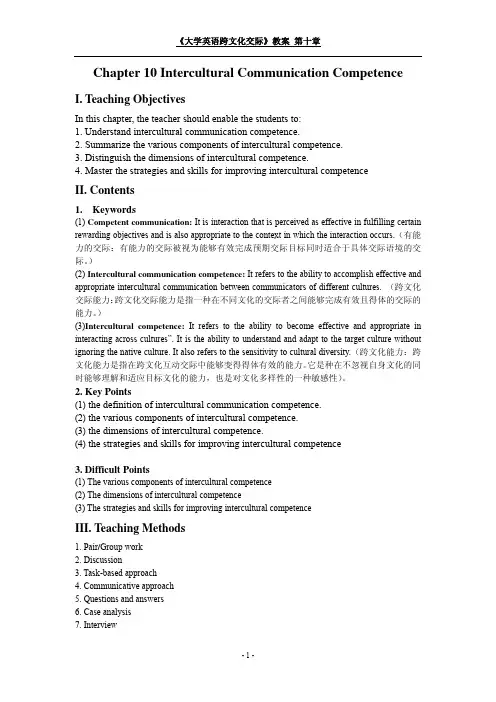
Chapter 10 Intercultural Communication CompetenceI. Teaching ObjectivesIn this chapter, the teacher should enable the students to:1. Understand intercultural communication competence.2. Summarize the various components of intercultural competence.3. Distinguish the dimensions of intercultural competence.4. Master the strategies and skills for improving intercultural competenceII. Contents1. Keywords(1) Competent communication: It is interaction that is perceived as effective in fulfilling certain rewarding objectives and is also appropriate to the context in which the interaction occurs.(有能力的交际:有能力的交际被视为能够有效完成预期交际目标同时适合于具体交际语境的交际。
)(2) Intercultural communication competence: It refers to the ability to accomplish effective and appropriate intercultural communication between communicators of different cultures. (跨文化交际能力:跨文化交际能力是指一种在不同文化的交际者之间能够完成有效且得体的交际的能力。
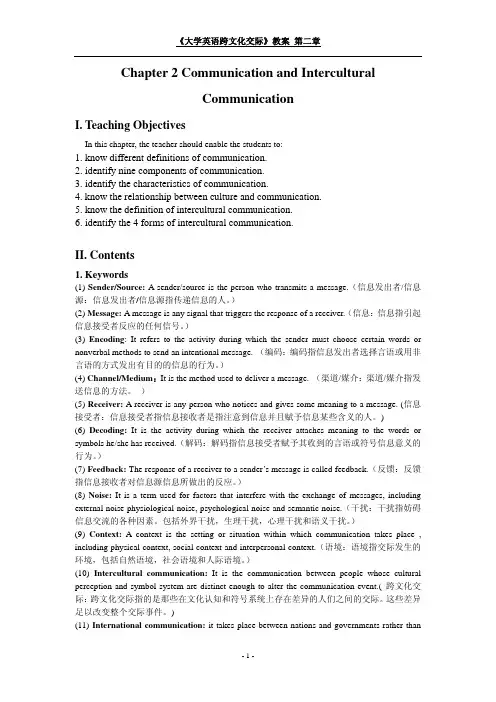
Chapter 2 Communication and InterculturalCommunicationI. Teaching ObjectivesIn this chapter, the teacher should enable the students to:1. know different definitions of communication.2. identify nine components of communication.3. identify the characteristics of communication.4. know the relationship between culture and communication.5. know the definition of intercultural communication.6. identify the 4 forms of intercultural communication.II. Contents1. Keywords(1) Sender/Source: A sender/source is the person who transmits a message.(信息发出者/信息源:信息发出者/信息源指传递信息的人。
)(2) Message: A message is any signal that triggers the response of a receiver.(信息:信息指引起信息接受者反应的任何信号。
)(3) Encoding: It refers to the activity during which the sender must choose certain words or nonverbal methods to send an intentional message. (编码:编码指信息发出者选择言语或用非言语的方式发出有目的的信息的行为。
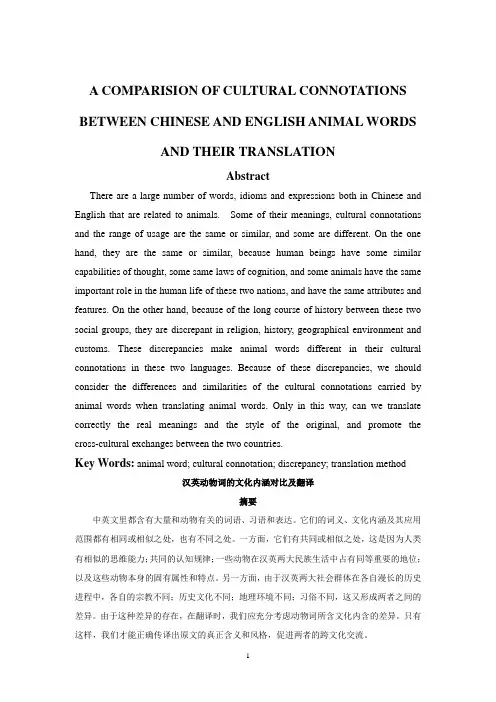
A COMPARISION OF CULTURAL CONNOTATIONS BETWEEN CHINESE AND ENGLISH ANIMAL WORDSAND THEIR TRANSLATIONAbstractThere are a large number of words, idioms and expressions both in Chinese and English that are related to animals. Some of their meanings, cultural connotations and the range of usage are the same or similar, and some are different. On the one hand, they are the same or similar, because human beings have some similar capabilities of thought, some same laws of cognition, and some animals have the same important role in the human life of these two nations, and have the same attributes and features. On the other hand, because of the long course of history between these two social groups, they are discrepant in religion, history, geographical environment and customs. These discrepancies make animal words different in their cultural connotations in these two languages. Because of these discrepancies, we should consider the differences and similarities of the cultural connotations carried by animal words when translating animal words. Only in this way, can we translate correctly the real meanings and the style of the original, and promote the cross-cultural exchanges between the two countries.Key Words: animal word; cultural connotation; discrepancy; translation method汉英动物词的文化内涵对比及翻译摘要中英文里都含有大量和动物有关的词语、习语和表达。
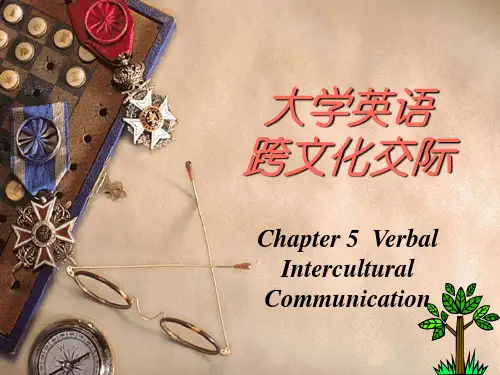
跨文化交际介绍英语作文Title: Cross-Cultural Communication: Bridging the Divide。
In our increasingly interconnected world, cross-cultural communication skills have become more crucial than ever before. Whether it's for business, travel, or simply building relationships, the ability to effectively communicate across cultures can open doors and foster understanding. In this essay, we will explore the importance of cross-cultural communication and provide practical tips for navigating cultural differences.First and foremost, understanding cultural differences is key to successful cross-cultural communication. Cultures vary in their communication styles, norms, values, and perceptions. What may be considered polite or appropriatein one culture may be completely different in another. For example, while direct communication is valued in Western cultures, it may be perceived as rude or confrontational insome Asian cultures where indirect communication is preferred.To navigate these differences effectively, it's essential to approach interactions with an open mind and a willingness to learn. Avoid making assumptions or judgments based on your own cultural perspective. Instead, take the time to observe and listen to how people communicate within a particular cultural context. Pay attention to non-verbal cues such as body language, gestures, and facial expressions, as these can convey important messages that may not be explicitly stated.Another important aspect of cross-cultural communication is language proficiency. While English has become a global lingua franca, it's important to remember that not everyone speaks English fluently. In fact, many people may feel more comfortable communicating in their native language. Therefore, it's helpful to learn some basic phrases in the language of the culture you're interacting with as a sign of respect and effort to bridge the language gap.Furthermore, cultural sensitivity and empathy are essential components of effective cross-cultural communication. Put yourself in the shoes of someone from a different cultural background and try to understand their perspective. Be mindful of cultural taboos, customs, and traditions, and avoid inadvertently causing offense. For example, certain topics such as politics, religion, and personal beliefs may be sensitive subjects in some cultures and should be approached with caution.In addition to interpersonal communication, technology has also played a significant role in facilitating cross-cultural interactions. Platforms such as social media, video conferencing, and messaging apps allow people from different parts of the world to connect and communicate instantaneously. However, it's important to be aware of cultural differences in the use of technology and to adapt your communication style accordingly.In conclusion, cross-cultural communication isessential for navigating our diverse and interconnectedworld. By understanding and respecting cultural differences, improving language proficiency, and practicing empathy and sensitivity, we can bridge the divide and build meaningful connections across cultures. As we continue to engage with people from different backgrounds, let us embrace the richness of cultural diversity and celebrate theopportunity to learn from one another.。
Ladies and Gentlemen,Good morning/afternoon/evening. It is a great honor to stand before you today and share my thoughts on an issue that is not only crucial for our personal growth but also for the advancement of our global society –the importance of embracing cultural diversity in higher education.As we gather here today, we are part of a unique community, a melting pot of cultures, beliefs, and experiences. This diversity is what makes our university special, and it is our responsibility to leverage this richness to create a more inclusive and understanding world.Firstly, let us acknowledge the importance of cultural diversity in our daily lives. We live in an interconnected world where people from different backgrounds come together to work, study, and share their lives. Higher education institutions are at the forefront of this global interaction, providing a platform for students to explore different cultures and ideas.One of the primary benefits of embracing cultural diversity in higher education is the enhancement of critical thinking skills. When students are exposed to a variety of perspectives, they learn to question assumptions, analyze information, and make well-informed decisions. This ability is invaluable in our increasingly complex and interconnected world.Furthermore, cultural diversity fosters creativity and innovation. When individuals from different cultures collaborate, they bring together a unique blend of knowledge, skills, and experiences. This diversity can lead to groundbreaking ideas and solutions that might not have emerged otherwise. In the words of Henry Ford, "Coming together is a beginning. Keeping together is progress. Working together is success."In addition to fostering critical thinking and innovation, embracing cultural diversity in higher education has significant social and economic benefits. A diverse student body can help bridge cultural gaps, promote tolerance, and reduce discrimination. This, in turn, contributes to a more harmonious and peaceful society.However, embracing cultural diversity is not without its challenges. One of the main challenges is the potential for cultural misunderstandings and conflicts. Language barriers, different customs, and values can lead to misunderstandings and even animosity. To address this, it is crucial for universities to provide students with the necessary tools and resources to navigate these challenges effectively.One way to achieve this is through cross-cultural training programs. These programs can help students develop cross-cultural communication skills, understand different cultural norms, and appreciate thediversity of their peers. By equipping students with these skills, we can ensure that they are better prepared to work and live in a global society.Another important aspect of embracing cultural diversity is promoting inclusivity in the curriculum. This means incorporating diverse perspectives and experiences into the teaching and learning process. For example, universities can offer courses on global issues, cultural studies, and international relations, which can help students develop a broader understanding of the world.Moreover, creating a welcoming and supportive environment is essential for embracing cultural diversity. This involves fostering an atmosphere where students feel valued and respected, regardless of their cultural background. In this environment, students can freely express their opinions, share their experiences, and learn from one another.In conclusion, embracing cultural diversity in higher education is a journey of understanding and growth. It requires commitment, effort, and a willingness to learn from one another. By doing so, we can equip students with the skills and knowledge needed to thrive in our increasingly diverse and interconnected world.Ladies and Gentlemen,To embrace cultural diversity, we must:1. Foster critical thinking and innovation through exposure to different perspectives and ideas.2. Promote inclusivity in the curriculum and create a welcoming environment for all students.3. Provide cross-cultural training programs to enhance communication and understanding.4. Bridge cultural gaps and reduce discrimination through education and awareness.As we embark on this journey together, let us remember that diversity is not a weakness but a strength. It is through our differences that we can learn, grow, and achieve great things. Let us work together to create a more inclusive, understanding, and prosperous world.Thank you for your attention, and I welcome any questions or comments you may have.---This speech is a general framework and can be expanded upon withspecific examples, personal anecdotes, or research findings to make it more engaging and tailored to the audience and context.。
大学英语中高级课程《跨文化交际》电子教案Week1 Culture and Intercultural Communication (I)I. Teaching objectives1. To get to understand what is culture and what is intercultural communication2. To get to understand different metaphors of culture3. 4. To understand how culture governs people‘s speech and behaviorsII. Classroom activities1.Brainstorming activity: What are the things that come up in your mind when you think of―Chinese culture‖?2.Definitions of culture—E.B.Tylor (1871) in Primitive Culture: ―that complex wh ole which includes knowledge, belief, art, morals, law, custom and any other capabilities and habits acquired by man as a member of a society.‖—Lustig & Koester: ―Culture is a learned set of shared perceptions about beliefs, values, and norms, which affec t the behaviors of a relatively large group of people‖—Gudykunst: Culture is our theory of the game being played in our society. We use our theory of the game being played in interacting with the other people we encounter. It tells us how to communicate with others and how to interpret their behavior. We generally are not highly aware of the rules of the game being played, but we behave as though there is general agreement on the rules.—Anthropologists: the total way of living3.Cultural mini-drama:Situation: Wang Liang worked in a Sino-German Joint V enture. One day, on his way to the coffee machine, he found that Wolfgang, one of his German colleagues, had seemingly gotten rather involved in a newspaper. Out of curiosity, Wang came up to Wolfgang so he could glance at the newspaper. Then he asked, ―Which one are you reading? Is it interesting?‖Mini-drama: What will happen to them then? Put students into several groups to perform the drama.The latter part of the drama: But all of a sudden, Wolfgang lost his temper, began to complain about Wang's invasion of his privacy, and demanded an apology for him. Wang felt rather upset, and kept explaining that he had not realized his behavior was rude. After this, whenever Wang stepped toward Wolfgang, he would soon cover up what he was doing, or stand up to keep a clear distance with Wang. Wang Liang got very confused, wondering why his friendly behaviors aroused such hostility in his colleague.4.Metaphors of culture—Culture is like the water a fish swims in, the sky a bird flies in, and the air people live in.—Culture is the software of our mind.—Culture is the grammar of our behavior.—Culture is like an iceberg.5.Classification of culture—high culture—popular culture—deep culture6.Movie clip appreciation—characters—key words•abuse n. mistreatment•attorney n. lawyer 律师•bruise n. an injury that shows up as a discoloration on the skin 瘀伤;擦伤•chitchat n. light informal conversation•conjecture n. a hypothesis that has little hard evidence•hearing n. a legal proceeding where evidence is taken for the purpose of determining an issue of fact and reaching a decision based on that evidence 听证会•incontrovertible n. impossible to deny or disprove•indisputably adv. cannot be disputed•inflict v. impose something unpleasant 施以;加害•ludicrous adj. inviting laughter荒谬的;可笑的•neglect n. lack of attention and due care•pending adj. waiting to be decided or settled•speculation n. a guess based on incomplete evidence•testimony n. something that serves as evidence—Phrases and expressions•put the cart before the horse: t o have things in the wrong order本末倒置—Cultural notes•CW A: Child Welfare Agency, a government organization intended to protect the rights of children•Guasha treatment (scraping therapy): A traditional Chinese medical treatment in which a wooden board repeatedly slides across the patient‘s acupuncture points. Itworks on the basis of principles similar to those of acupuncture and massage. Thus,ailments that can be treated by acupuncture and massage can be helped withGuasha as well. It can help reestablish the human body‘s natural biologi calcirculation.•ER: emergency room•―Show me‖ state: A nickname for Missouri, a midwestern state in the central United States. This term appears on automobile license plates for Missouri.—Pairwork exercises7.Explore interculturally(group discussion and presentation)—In the hearing, why does Xu Datong invite John to be his lawyer although John is not familiar with family law? What can you learn from it about Chinese culture?—Why doesn‘t John defend Xu Datong in the hearing? What ca n you learn from this?—Why does Xu Datong tell the judge he performed Guasha on Dennis? What can we learn from this about Chinese culture?8.Intercultural communication: Communication between people from different culturalbackground.III. Assignments1. Explain the metaphors of culture.2. Cite some daily examples to illustrate how culture governs people‘s speech and behaviors.Week2 Culture and Intercultural Communication (II)I. Teaching objectives1. to get to learn various classifications of culture2. to get to understand what is intercultural communication3. to get to understand why we should study intercultural communicationII. Classroom activities1.Check the assignments of last week.—Explain the metaphors of culture.—Cite some examples to illustrate how culture governs people‘s speech and behaviors.2. A social survey: Culture shapes people‘s view.3.Classifications of culturea)High culture, popular culture, deep cultureb)Big culture, small culturec)Mainstream culture, subcultured)Eastern culture, western culturee)Eastern culture, Indian culture, western culture (梁漱溟)f)Eastern culture, Indian culture, Arabic culture, European culture (季羡林)g)Food culture, wine culture, tea culture etc.4.Case studyQuestions for discussion:—Why didn‘t the man change the sea t as required by the stewardess?—What can you learn from it about Chinese culture?—Any other comments about the case?5.What is intercultural communication?—Communication between people from different cultural background.6.Why study intercultural communication?Let there be a small country with few people…Though neighboring communities overlook one anotherand the crowing of cocks and barking of dogs canbe heard, yet the people there may grow old anddie without ever visiting one another----- Lao Tze《老子》:―甘其食,美其服,安其居,乐其俗。